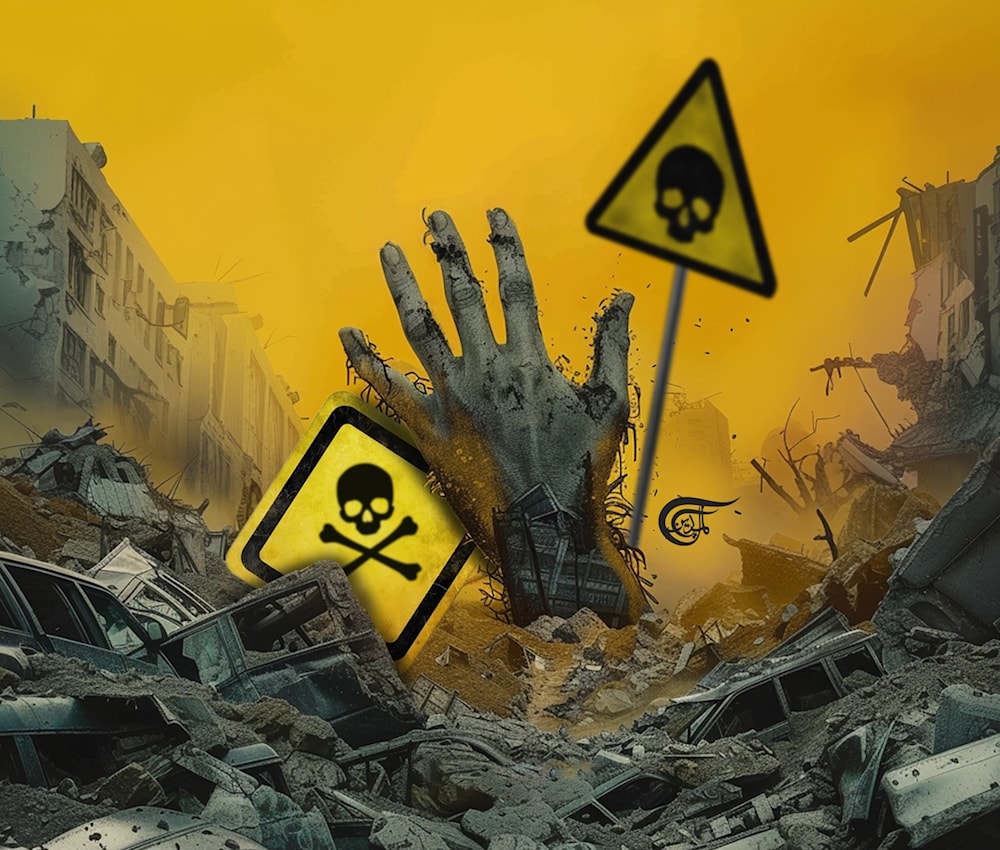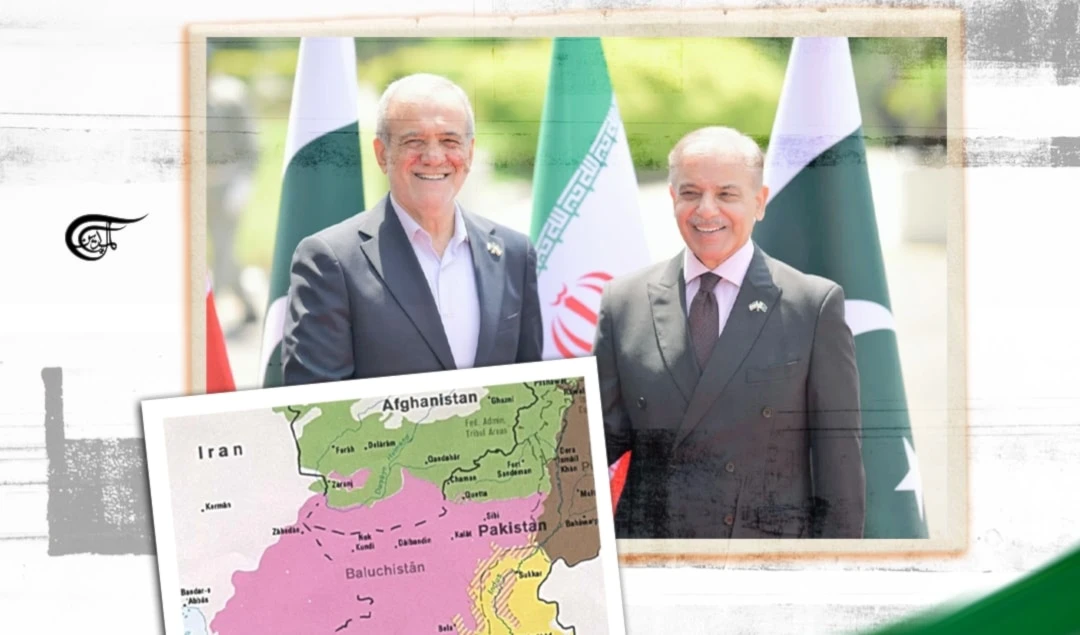Environmental destruction in Gaza yet to make a dent in global conscience
The situation in Gaza is dire, and environmental organizations are showing concerns regarding the catastrophic impacts on Gaza's ecosystems and biodiversity.
-

The environmental and civilian consequences in Gaza, while not precisely comparable to the devastation of World War II, are alarming and significant. (Al Mayadeen English; Illustrated by Zeinab el-Hajj)
The atrocities committed by Israeli forces in Gaza bear resemblance to the relentless bombardment of German cities by coalition forces during World War II. In less than seven weeks, from October to December, the occupation forces dropped a staggering 30,000 explosives in Gaza. This is equal to the overall quantity of bombs dropped by US-UK forces during their invasion of Iraq in 2003.
Not only did the Zionist state's ceaseless bombardment result in the deaths of over 32,000 Gazans and the entrapment of scores of bodies beneath the debris of destroyed structures, but it also inflicted unprecedented damage on the environment. Munitions and toxins contaminate the soil and groundwater, reducing olive plantations to compacted earth, clogging the sea with sewage and garbage, and polluting the air with smoke and particulate matter.
The situation in Gaza is dire, and environmental organizations are showing concerns regarding the catastrophic impacts on Gaza's ecosystems and biodiversity. Demands have arisen to classify this devastation as "ecocide" and potentially investigate it as a war crime. The environmental and civilian consequences in Gaza, while not precisely comparable to the devastation of World War II, are alarming and significant.
UNEP is unable to investigate
Although the United Nations Environment Program (UNEP) is digging deep into the environmental impact of the war in Gaza to get a clear picture of the sky-high levels of land, soil, and water pollution, it hasn't been able to hit the ground running with field-based surveys in Gaza due to "Israel's" non-stop attacks on civilian targets, including hospitals and residential places.
In late January, UNEP's executive director, Inger Andersen, said during a speech that they had given the green light to an official request from the State of Palestine to conduct an environmental impact assessment in Gaza. Last month, Andersen demonstrated UNEP's unwavering commitment during the sixth session of the United Nations Environment Assembly in Nairobi, where she met Dr. Nisreen Al-Tamimi, the chairperson of the Environment Quality Authority of the State of Palestine.
Early last month, Adele Khodr, the regional director of UNICEF for the Middle East and North Africa, issued a statement in which she disclosed distressing accounts of infant deaths caused by starvation and thirst in the Northern Gaza Strip. She said that these tragic and abhorrent fatalities were preventable and were man-made, and stated that environmental concerns paled in comparison to the tremendous human suffering. Nevertheless, the persistent humanitarian crisis has inextricably linked these two phenomena. Water pollution has resulted from the bombardments, causing a dearth of potable water and an increase in the incidence of waterborne maladies.
Based on media reports, UNEP endeavored to acquire an initial comprehension of the magnitude of environmental damage by analyzing satellite imagery, gathering information from UN entities on the ground, and drawing upon knowledge of the repercussions of previous conflicts (including those in Gaza and other areas). It can be concluded from the preliminary data that the conflict has significantly increased land, water, and sediment contamination and released dangerous substances into the ecosystem. UNEP's initial findings reveal a daily discharge of at least 100,000 cubic meters of sewage and wastewater onto land or into the Mediterranean Sea. These discharges result in elevated concentrations of chlorophyll, suspended organic matter, and gastrointestinal parasites in coastal waters.
The ceaseless barrage has displaced nearly 27 million tons of detritus, posing challenges in addition to air, soil, and water pollution. The detritus and rubble may comprise various hazardous substances, including but not limited to asbestos, heavy metals, fire contaminants, unexploded ordnance, and hazardous chemicals.
Where does 'Israel' acquire weapons from?
Late last year, a Guardian investigative report purportedly established that the United States government has granted "Israel" clandestine access to highly secured warehouses set up on Israeli territory, which contain weapons valued at billions of dollars. In the 1980s, the United States government established the stockpile, intending to swiftly supply American forces in potential future conflicts in the Middle East. The United States government currently allows "Israel" to utilize its vast reserves. "Israel" obtained substantial quantities of munitions from the stockpile to utilize in its conflict with Gaza.
The stockpiles in question have brought the Biden administration into greater scrutiny, coinciding with mounting pressure over its endorsement of "Israel's" bombardment of Gaza. The indiscriminate nature of "Israel's" bombardment of Gaza is a subject of widespread concern. The US government is currently facing inquiries about the quantities and types of weapons it supplies to "Israel" and the proportion that is available through the hidden, pre-positioned stockpile.
A White House proposal sought to loosen restrictions on the types of weapons placed in the stockpile, exempt spending limits on its replenishment, and grant the Pentagon more latitude in transferring items from the arsenal of perturbed legislators in Washington.
In protest of Washington's continued lethal assistance to "Israel", Josh Paul resigned from his position at the State Department. He stated that the proposed changes to the stockpile were part of an effort by the Biden administration to find new methods to supply "Israel".
Aggressive use of dumb bombs
"Israel" bombarded Gaza with tens of thousands of dumb bombs, destroying private properties, public structures, hospitals, and schools, as well as environmental degradation and the loss of a proportionally significant number of civilian lives. Considerable apprehension arises regarding the effects of unguided "dumb bombs" on civilian populations and infrastructure amidst the conflict.
A U.S. intelligence assessment has determined that nearly half of the munitions "Israel" has employed in Gaza since the start of the conflict have been unguided explosives. This proportion, according to arms experts, helps to explain the conflict's astronomical civilian casualty rate. The disclosure coincides with heightened deliberations between "Israeli" and U.S. authorities concerning the order in which military campaigns have been conducted throughout the conflict. A recent assessment by the Office of the Director of National Intelligence reveals that only 55% to 60% of munitions used by the occupation forces from October 7 to December 2023 have been precision-guided, while the rest were "dumb bombs". Humanitarian organizations and others are concerned about the substantial number of unguided bombs in use as demands increase both within and outside the United States for Washington to immediately reduce civilian casualties before extending additional military assistance to "Israel".

 F.M. Shakil
F.M. Shakil
 6 Min Read
6 Min Read











